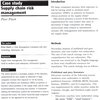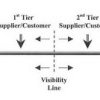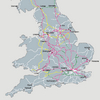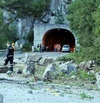 I just learned from the news this evening, while writing on a rather dull post for this blog, that a rockfall has hit one of major roads in this region, Rv 70 in Sunndal. Rockfall is not an unknown event in Norway, especially not in this region, where roads undulate precariously along high mountains, and where the only “escape” is a dive into freezing cold waters. The road in question has a long history of rockfalls and the incident has cut off the most direct route between the coastal city of Kristiansund and Eastern Norway, but fortunately a detour route is available. In Norway’s sparse transportation network that is not always the case, and closed roads mean additional travel costs not only to the ordinary traveller (i.e. tourist), but most importantly to businesses, who then have no alternative for shipping their goods to their customers, or receiving their goods from their suppliers.
I just learned from the news this evening, while writing on a rather dull post for this blog, that a rockfall has hit one of major roads in this region, Rv 70 in Sunndal. Rockfall is not an unknown event in Norway, especially not in this region, where roads undulate precariously along high mountains, and where the only “escape” is a dive into freezing cold waters. The road in question has a long history of rockfalls and the incident has cut off the most direct route between the coastal city of Kristiansund and Eastern Norway, but fortunately a detour route is available. In Norway’s sparse transportation network that is not always the case, and closed roads mean additional travel costs not only to the ordinary traveller (i.e. tourist), but most importantly to businesses, who then have no alternative for shipping their goods to their customers, or receiving their goods from their suppliers.
Safe or save?
Preliminary reports indicate that the rockfall has affected some 100 meters of road between two tunnels. Not much maybe, but two cars were caught by the falling rocks; luckily there were no casualties. This scenario is not uncommon in Norway, where in an effort to save money, instead of building one long tunnel past such problem areas, the solution more often than not is building two short tunnels, leaving some exposed and supposedly “safe” area in between, with the result that incidents and closures do happen. from time to time.
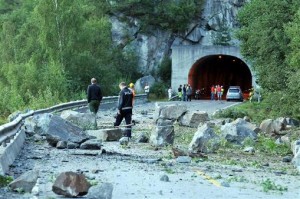
If they happen often enough, the cost of closures and repairs, not to mention the cost of lives lost, ay exceed the cost it would have been to build the long tunnel, but such long term evaluations are usually not part of the decision making, as I pointed out in an article some time ago, contending that reliability and vulnerability should be part of infrastructure investment decisions: Reliability and Vulnerability – A non-issue in cost-benefit analyses? (Pålitelighet og sårbarhet – et ikke-tema i nyttekostanalyser?)
The cost of disruptions
In a recent study undertaken by the Molde Research Institute in Norway, a point is made that the typical socio-economic impact of road network disruptions in Western Norway varies greatly, depending on a) the traffic volume, b) the actual possibilities of rerouting traffic and c) the composition of the traffic that uses the impacted road. The study comprised 7 of the most avalanche-prone Norwegian counties with a total population of 1.7 million and a total road length of 38,000 kilometers (23,000 miles). Over a five-year period, 2001-2006, the average number of registered incidents was 136 incidents per year, with an average closure time of 16 hours per incident. The average hourly socio-economic cost was calculated to be $4,000 per incident, varying between mere $400 and as much as $16,000 per hour, depending on the three factors mentioned above. What should be noted here is that these are generalized costs, which do not take into account the actual and individual losses that are incurred by travelers, freight haulers or businesses at either end of the supply chain.
Too late
I’m sure that the road administration authorities now will consider the long tunnel, but shouldn’t they have done that in the first place?
References
- Bråthen, S. Lægran, and S., Husdal, J. (2004) Flaskehalser for langdistanse godstransport på veg (Norwegian) Project report no. 245701, Sweco Grøner, Oslo, Norway. English: Bottlenecks in Road Freight Transport in Norway
- Bråthen, S., Husdal, J. and Rekdal, J. (2008). Samfunnsøkonomisk verdi av rassikring (Norwegian). Report 0801, Molde Research Institute, Molde, Norway. English: The socio-economic value of avalanche and rockfall mitigation.
- Husdal, J. (2005) The vulnerability of road networks in a cost-benefit perspective. Proceedings of the the Transportation Research Board Annual Meeting (TRB 2005), Washington DC, USA, 9-13 January 2005.
Related
- husdal.com: Sparse transportation networks – a recipe for supply chain disruptions
- husdal.com: Sparse transportation networks – a nightmare for supply chains
- husdal.com: Norwegian roads are sloooow
- husdal.com: How come one of richest countries in the world has the world’s worst roads
News
- aftenposten.no: To biler tatt av stort steinskred i Sunndal
- aftenposten.no: Det regnet kampesteiner
- vg.no: To biler truffet av steinras
- vg.no: Fryktet ras før ulykken
- vg.no: Vi hadde englevakt
- dagbladet.no: Flere biler tatt i steinras
- dagbladet.no: Det raste hele tida
- NRK Møre og Romsdal: Steinskred på Oppdølsstranda
- NRK Møre og Romsdal: Omstridd vegstrekning
- NRK Møre og Romsdal: Sunndal kommune lager beredskapsplan
- NRK Møre og Romsdal: Vegen stengd i heile dag
- rbnett.no: Alvorlig skadd etter skred i Sunndal
- nettavisen.no: Kjørte for livet gjennom raset
- adressa.no: To bygder er fysisk avstengt
- tk.no: Bilder fra rasstedet
- tk.no: Slapp mirakuløst unna
- tk.no: Har inspisert rasområdet
- dagsavisen.no: Kritisk for rasofferet
- tu.no: Rasveien kan bli stengt i dagesvis

